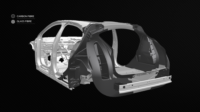Cutting-Edge R&D Project Aims to Optimize AV Connectivity

SAN ANTONIO—The U.S. Department of Energy has awarded a three-year, $5.25 million contract to the Southwest Research Institute (SwRI) to develop connected and automated vehicle (CAV) technologies to help reduce energy consumption and carbon emissions. The project is the second phase of the Advanced Research Projects Agency-Energy's (ARPA-E's) Next-Generation Energy Technologies for Connected and Autonomous On-Road Vehicles (NEXTCAR) program.
Phase I focused on the development of CAV technologies for use in all vehicle classes, including cars, trucks and buses, with the goal of enabling a 20 percent reduction in energy consumption. The next goal is to achieve a 30 percent reduction. SwRI engineers will integrate test vehicles with Level 4 automation technology, which gives them the ability to perform all driving operations on their own with optional human override.
"We are excited to have the opportunity to continue developing this technology to optimize vehicle efficiency," says Scott Hotz, an assistant director in SwRI's Powertrain Engineering Division and leader of the NEXTCAR project through SwRI's Ann Arbor Technical Center in Michigan. "It will have enormous benefits, not only to the automotive industry, but more importantly, also to the public by reducing carbon emissions."
During the first phase, SwRI developed optimal control algorithms to leverage vehicle-to-vehicle (V2V), vehicle-to-infrastructure (V2I) and other vehicle-to-everything (V2X) technologies to simultaneously optimize route, speed profile and power flows from the hybrid system on a 2017 Toyota Prius Prime plug-in hybrid electric vehicle. Engineers demonstrated a more than 20 percent improvement in energy consumption in real-world driving conditions through a combination of vehicle dynamics and advanced power train control algorithms, including eco-routing, eco-driving and power-split optimization.
"Vehicle connectivity and automation are already being used to effectively improve safety and driver convenience," claims Sankar Rengarajan, manager of SwRI's Powertrain Controls Section. "We tapped into those existing data streams and put the information to use in a new way to help us achieve a 22 percent gain in fuel efficiency."
In the second phase, SwRI will build on those technologies and expand its predictive eco-routing, eco-driving and hybrid power control strategies. The eco-driving feature focused on longitudinal dynamics control and contributed about 10 percent of the energy savings.
“The algorithm helped the human driver make smarter decisions based on localized traffic knowledge through V2X connectivity and communication,” says Rengarajan. “Because of the advanced perception and actuation precision of a Level 4 autonomous vehicle over a human driver, [we] will expand the eco-driving framework to optimize for multilane dynamics and further reduce energy consumption.”
Looking for a reprint of this article?
From high-res PDFs to custom plaques, order your copy today!






